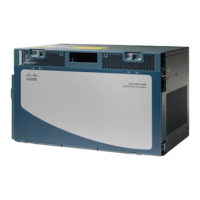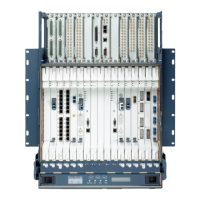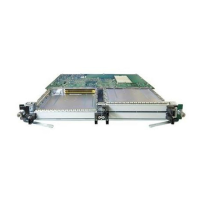2-218
Cisco ONS 15454 Troubleshooting Guide, R8.5
November 2009
Chapter 2 Alarm Troubleshooting
2.7.357 SD (E1)
Clear the SD (DS1, DS3) Condition
Step 1 If the condition applies for a DS-3 line on a DS3XM-6, DS3XM-12, DS3E-12, or DS3/EC1-48 card,
complete the “Clear a DS3XM-6, DS3XM-12, or DS3E-12 Card Loopback Circuit” procedure on
page 2-276. If the condition applies to any other DS-N card (DS3i-N-14, DS3-12, DS3i-N-14, or
DS1/E1-56) complete the “Clear Other Electrical Card or Ethernet Card Loopbacks” procedure on
page 2-277.
Caution Always use the supplied electrostatic discharge wristband when working with a powered ONS 15454.
Plug the wristband cable into the ESD jack located on the lower-right edge of the shelf assembly.
Step 2 Ensure that the fiber connector for the card is completely plugged in. For more information about fiber
connections and card insertion, refer to the “Install Cards and Fiber-Optic Cable” chapter in the
Cisco ONS 15454 Procedure Guide.
Step 3 If the BER threshold is correct and at the expected level, use an optical test set to measure the power
level of the line to ensure it is within guidelines. For specific procedures to use the test set equipment,
consult the manufacturer.
Step 4 If the optical power level is good, verify that optical receive levels are within the acceptable range.
Step 5 If receive levels are good, clean the fibers at both ends according to site practice. If no site practice exists,
complete the procedure in the “Maintain the Node” chapter in the Cisco ONS 15454 Procedure Guide.
Step 6 If the condition does not clear, verify that single-mode fiber is used.
Step 7 If the fiber is of the correct type, verify that a single-mode laser is used at the far-end node.
Step 8 Clean the fiber connectors at both ends for a signal degrade according to site practice.
Step 9 Verify that a single-mode laser is used at the far end.
Step 10 If the problem does not clear, the transmitter at the other end of the optical line could be failing and
require replacement. Refer to the “2.9.4 Physical Card Reseating, Resetting, and Replacement” section
on page 2-272.
Step 11 If the condition does not clear, log into the Technical Support Website at
http://www.cisco.com/techsupport for more information or call Cisco TAC 1 800 553-2447.
2.7.357 SD (E1)
Default Severity: Not Alarmed (NA), Non-Service-Affecting (NSA)
SONET Logical Object: E1
An SD condition for an E1 occurs on a DS1/E1-56 card in E1 only mode when the quality of an electrical
signal has exceeded the BER signal degrade threshold.
SD is triggered at a lower bit error rate than SF. The SD BER threshold is user-provisionable and ranges
from 1E–9 dBm to 1E–5 dBm.
SD can be reported on electrical card ports that are In-Service and Normal (IS-NR); Out-of-Service and
Autonomous, Automatic In-Service (OOS-AU,AIS); or Out-of-Service and Management, Maintenance
(OOS-MA,MT) but not in the Out-of-Service and Management, Disabled (OOS-MA,DSBLD) service
state. The BER count increase associated with this alarm does not take an IS-NR port out of service, but
if it occurs on an AINS port, the alarm prevents the port from going into service.

